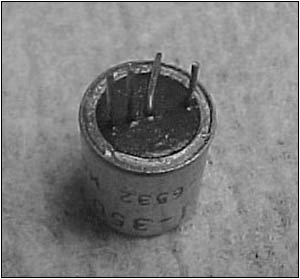Of Old Radios And Related Items--Published Monthly
"Bad" Trans-Oceanic Transistors Work Again!
BY MAL FULLER
Web Edition
Repairing defective transistors may seem impossible, but Mal Fuller tells us how. (Editor)
My focus in the radio hobby leans towards AC-powered radios of the 1920s and 1930s. But, recently I was offered a Zenith Royal 3000-1 Trans-Oceanic for a price I could not refuse. Though in nearly mint condition, only the FM worked.
"That's common," I was told by several radio buddies. The problem is usually either the RF amplifier, the oscillator, or the mixer transistor in the AM "front end."

Figure 1. A bottom view of one of the transistors used in the Zenith Royal 3000. From left to right, the leads are emitter, base, case ground and collector. Note that the case ground pin has been bent over so that it will not make contact with the socket."Good luck finding replacements!" they added.
With the benefit of a Zenith service manual, I found that in the AM front end, there are seven test points, easily accessible without any disassembly. Test point #7 in the collector supply of the mixer transistor was 0 volts instead of -6.7 volts.
I turned the radio off, removed the mixer transistor and repowered the radio. Presto, the correct voltage appeared. A shorted transistor, I thought.
I like to check transistors with an ohmmeter. As many of you know, a few forward and reverse checks on the emitter, base and collector, and a bad (or good) transistor can usually be identified. I looked for the collector-to-emitter short I expected to find. Instead, I found only normal readings on the transistor's three elements!
You Don't Suppose...
Whenever I'm puzzled I scratch my head. After my head was well scratched, a "you don't suppose" idea came to me. Many transistor types have three leads, but, as you can see in Figure 1, these transistors have four leads. The additional lead connects the transistor's metal case to chassis ground. Figure 2 is a closeup of the AM tuner section of the Royal 3000-1 and shows the three transistors used there.
A test with my ohmmeter revealed that the collector of the mixer transmitter was shorted to the metal case of the transistor! With fingers crossed, I bent the ground lead over so it would not engage with the transistor socket. I put the transistor back and turned on the radio. Nothing. But, when I went to test point #7 the 6.7 volts were there.
Another "you don't suppose" thought came to me. I removed the oscillator transistor and cut to the chase. Sure enough, while not a dead short in this instance, there was a resistance reading between the case of the transistor and the collector. I bent that transistor's ground lead over in the same fashion as I have already described and plugged it back in. This time, when I powered the radio, it worked flawlessly on all bands.
Of course, I can't say how many of the shielded transistors that Zenith used have failed in this manner. But, I thought it worth sharing since two out of the three transistors in my set's AM front end were so afflicted.
Good substitutes for these transistors are elusive. Most, I understand, will at best cause some degradation of performance, likely, in 1L6 fashion, on the higher frequencies. With the shields disconnected I can find no problem -- all bands are right on frequency. Further, everything about the Royal 3000-1 constitutes a shield! Hope this is a help to fans of this and perhaps other Zenith all-transistor models.
(Mal Fuller, 624 North Main St., Wolfboro, NH 03894)
As a "sort of" apprentice, Mal Fuller began fixing radios and televisions before his voice changed. Radio and television repair remained his vocation until the 1980s. While always a collector, he has also returned, full-time, to fixing old tube-type radios for others.
| [Free Sample] [Books, etc., For Sale] [Subscribe to A.R.C./Renew] [Classified Ads] [Auction Prices] [Event Calendar] [Links] [Home] [Issue Archives] [Book Reviews] [Subscription Information] [A.R.C. FAQ] URL = http://www.antiqueradio.com/Oct04_Fuller_transistor.html Copyright © 1996-2004 by John V. Terrey - For personal use only. Last revised: September 27, 2004. For Customer Assistance please contact ARC@antiqueradio.com or call (866) 371-0512 Pages designed/maintained by Wayward Fluffy Publications
Antique Radio Classified |